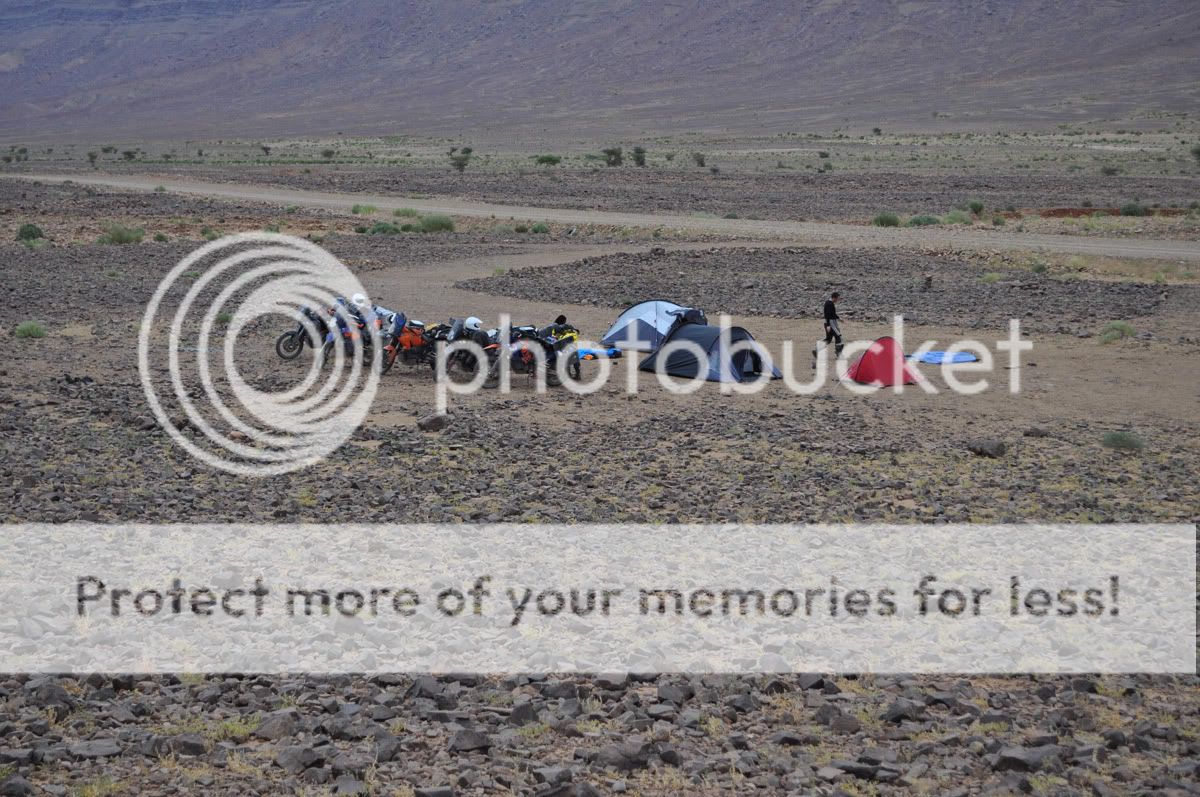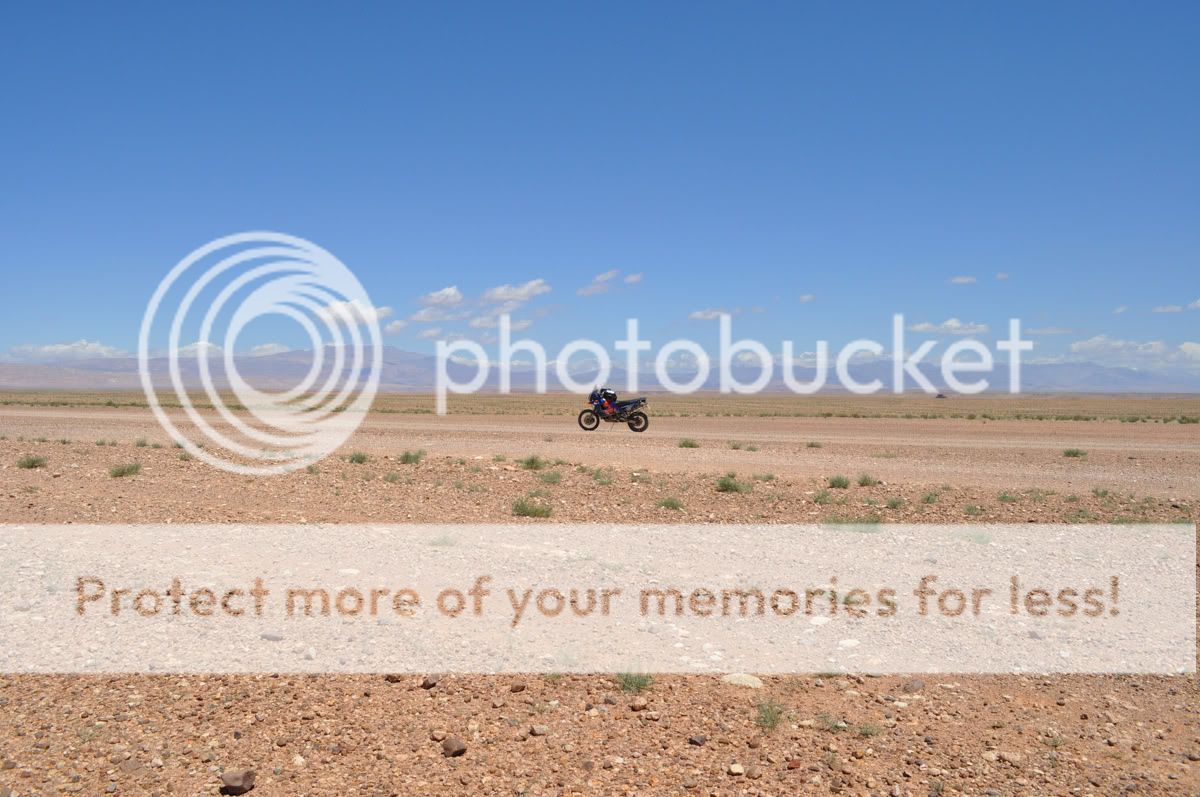Almost inevitably given the condition of the road, one of us got a puncture: it was Mark H’s font tyre than went down. We’d prepared for this and all of us were carrying spare inner tubes, and we had a selection of tyre levers too. Removing the wheel from the bike, Gareth set about changing the tube – it was a classic compression puncture undoubtedly caused by one of the many rocks that littered the road.
We’d only just set to work when three children appeared from nowhere. The sat on a rock and watched us quietly, not asking for a sweet, money or anything else. When we’d finished, they just wandered off in to the desert again – you’re never alone anywhere in Morocco, there’s always someone watching somewhere.
Back on the road we caught up with Mark L and Jason, and we all came to the same conclusion that the desert was really boring and decidedly over-rated. And we now understood Tim’s comment about having better things to do too!
Our revised plan was to continue to Zagora and instead of spending another couple of days trudging through the desert to Taouz, we’d go via surfaced roads and get there today.
As we got closer to Zagora the surface improved, and widened out. There was also an increase in the amount of traffic – i.e. there was some. A group of Dutch bikes, travelling light on Yamahas, a pair of 4x4s and we passed an encampment with other 4x4s parked in the rare shade of a tree.
The wide, flat road gave a chance for another photo call with the bikes lined up in the middle of the road:
Photo by Mark Littlewood
Arriving in Zagora we found the famous “52 Days to Timbuktu” sign, and took photos to prove we really were there. It was hot, I was tired, and the shade of a palm tree was appealing – so much so that I fell asleep, sat on the kerb, propped up by my own body armour, much to amusement of the others and bystanders.
Photo by Mark Littlewood
One of the bystanders, a chap on a moped, told us he was a big KTM fan (big fan of KTMs or a fan of big KTMs? Don’t know – it doesn’t matter) and persuaded us to visit his garage. We were a little reluctant but when we rode round there we were treated like minor celebrities – the other guys in the garage all wanted photos, as did passers-by, and we took a few too. It turned out that they’d worked on KTMs in the Dakar Rally when it last came through Zagora, and the wall of the garage was covered in pictures of the various cars, trucks and bikes they’d worked on.
Photo by Mark Littlewood
When we eventually extricated ourselves, with all the bikes now wearing Desert Garage Zagora stickers, we headed in to the town centre for some lunch. There was something about five dusty bikes parked at the kerb-side of a bustling African town-centre street that brought to mind horses tethered outside a saloon in the wild-west. Declining an invitation from the neighbouring shopkeeper to view his wares, we followed the main road east towards the sand dunes at Erg Chebbi. The first petrol station we stopped at had a faulty pump, so after filling two of the bikes painfully slowly we decided to do the other three elsewhere. As a main road, petrol stations were fairly frequent so this wasn’t a problem.
The road initially followed a river, which wound is way through a narrow rocky valley below the road, with lush green vegetation along its banks. From the numerous roadside peddlers, it was obvious we were again in prime tourist territory – dates this time. The air was hot and humid, and opening your visor for air was just like having a hot hairdryer blowing in your face. As the afternoon went on, it got even hotter and although we didn’t have a thermometer with us, it must have been in the high thirties if not the low forties.
Leaving the main road for a more minor, cross-country, road we found that Moroccan speciality: the rustic roadwork diversion. The old single track of tarmac with gravel edges was being replaced with a new, full-width tarmac road and where the work was still in progress, traffic was just diverted off in to the desert alongside. This suited the big KTMs just fine, and we loped along at a reasonable pace. Dust was the biggest hazard, with clouds of it being thrown up by other traffic making passing anything, in either direction, an exciting experience.
What did come as a surprise were further convoys of road bikes heading in the opposite direction. They were travelling at a very sedate pace through the works, and even the pseudo-trail bikes’ riders were being cautious. The last stretch of diversion helped to explain it: deep, loose sand right at the end (for us) or beginning of the diversion – entertaining for us, but probably a nightmare for non-dirt riders.
Erring again on the side of caution, we stopped to re-fuel again at around 140 miles from Zagora and to take on plenty of water. We were surprised, although with hindsight it seems obvious, that many petrol stations have, in addition to the more usual facilities, a prayer room.
Throughout the trip, the Islamic influence was one of the more visible reminders that we were in a very different place – simple things like pharmacies having a green crescent on the sign instead of a green cross, and in most towns the minarets of mosques could be seen much like our parish church spires, and the call to prayer from the muezzin; just like our church bells. Riding through towns at certain times, especially on Fridays, we would see a huge number of people making their way to Friday prayers, mostly on foot.
Rissani was our next major town, and getting through it was slightly nerve-wracking. The throngs of people on foot, bicycle and mopeds, most of them with no road-sense or awareness, making their way through the narrow main roads of the town, meant staying extra vigilant as they variously wandered or pulled out in front of us, overtook and generally got in the way. We got split-up through the town, and it was with some relief that when we re-grouped the other side of the town none of us had collected anyone on the way – I’d say more down to luck than judgement.
We'd been given the name of a hotel, but not precise directions to it. Unlike most places, the hotels are not neatly lined up along the roadside, but scattered across the desert around the sand dunes. We selected one more or less at random, and followed the coloured poles they'd thoughtfully provided across the nothingness to the hotel.
Compared to the other places we'd stayed, this was a very grand establishment with a swimming pool, bar, open-air restaurant, house parrot and air conditioning in the chalet-style rooms. Most of the walls were made of mud and straw, and apart from reception and the rooms themselves, everything else was outside with drapes and canopies to provide shelter from the sun.
Our room was the “family” room, with a double bed and four single beds. I was very generously given use of the double after my falling asleep on the roadside earlier.
After taking the opportunity to freshen up a bit, we convened for drinks on the terrace – Moroccan brewed Flag beer. And it fitted the bill perfectly.
Dinner was another tagine, beef and apple this time, and delicious – the best meal we had all trip. We had a bottle of red wine to go with it, from Meknes. There was also a proper dessert on offer, in fact a selection of them, and I had a chocolate mousse.
Tomorrow was going to be highlight of our trip: a day playing in the sand dunes at Erg Chebbi.





























